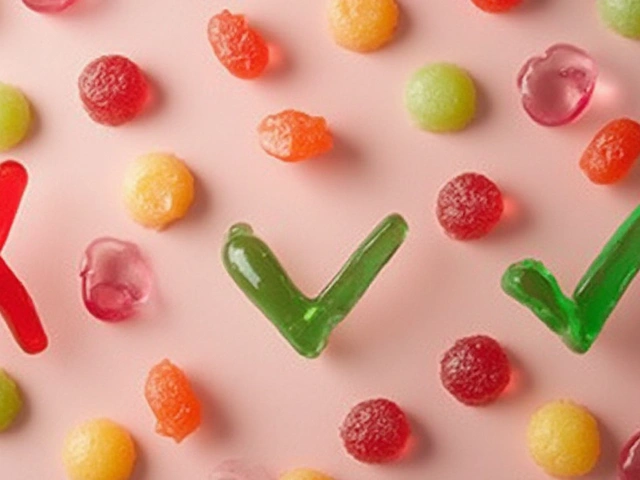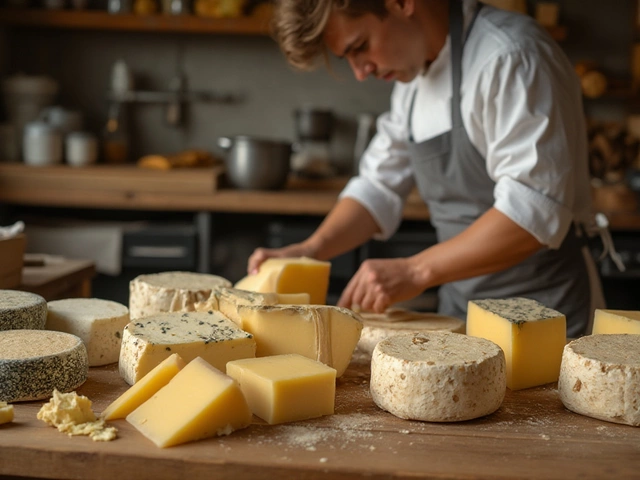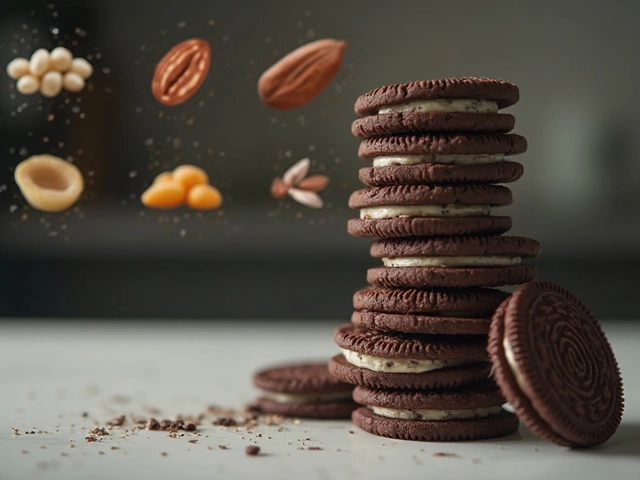Pavlova isn’t just a pretty face—it’s a science experiment that you get to eat. At its core, pavlova lives or dies by its ingredients, and even a tiny slip can mean the difference between chewy perfection and a sad, weepy mess.
If you’ve ever wondered why your meringue cracks or stays sticky, it probably comes down to what you put in the bowl. The basics are simple: eggs, sugar, a little acid, something starchy, and whatever you want up top. But each ingredient has a job to do.
Let’s get straight to the point and break down which ingredients you really need and what they actually do. Whether you’re hoping for that glossy shell or a pillowy center, the right stuff makes all the difference.
- The Heart of Pavlova: Meringue Base
- Egg Whites: Getting the Foundation Right
- Sugar’s Sweet Role and Type Choices
- Must-Have Additions: Cornstarch and Vinegar
- Extra Touches: Toppings and Flavors
The Heart of Pavlova: Meringue Base
If pavlova had a soul, it would be the meringue base. This is where things can go wonky or totally wow your taste buds. The classic pavlova base is a combo of egg whites and sugar, whipped until stiff and glossy—think marshmallow fluff in texture, not dry styrofoam. The biggest secret? The ratio is king. Most bakers swear by about 50 grams of sugar per egg white, but here’s what really matters inside the bowl.
| Ingredient | Purpose |
|---|---|
| Egg Whites | Structure, fluff, and rise |
| Sugar | Stability, sweetness, glossy finish |
| Cornstarch | Soft center, reduces weeping |
| Acid (vinegar or lemon juice) | Stabilizes foam, keeps meringue tall |
Notice that there’s no room here for yolks—any fat at all will wreck your meringue game. A quick tip: use room temperature eggs for max volume. If you just pulled them from the fridge, let them sit on the counter for 30 minutes. Cold egg whites just don’t whip up as fluffy.
Don’t overdo the beating either. Once the sugar is in and it’s glossy, stop. Overwhipping leads to cracks and a rough texture when you bake. You want nice, stiff peaks—when the mixture can stand up on the beater, it’s ready.
Here’s a breakdown of what your mixing bowl should have for an average pavlova:
- 4 large egg whites
- 1 cup (200g) superfine sugar
- 2 teaspoons cornstarch
- 1 teaspoon white vinegar or lemon juice
This is the starting point for the pavlova most folks crave: crisp on the outside, soft in the middle, never flat or rubbery. Try these amounts and you’ll avoid most of the rookie mistakes that make pavlova stressful.
Egg Whites: Getting the Foundation Right
Egg whites are the backbone of any pavlova. Without them, you just can’t whip up that dreamy, cloud-like meringue. Let’s get real: not all eggs are created equal for this dessert. Fresh eggs tend to make a stiffer foam, but slightly older eggs—think about a week old—actually whip up better, giving you taller, fluffier peaks. Room temperature egg whites trap air easier, so it’s best to let them sit out for about 30 minutes before you even reach for your pavlova recipe.
Cleanliness matters here. Any grease or yolk at all in your mixing bowl and those whites will refuse to fluff up. Use a metal or glass bowl, not plastic, because plastic can hang onto oils you didn’t even know were there. Even a drop of water in the bowl can mess with your foam.
If you want to get super specific, here’s a quick look at how much egg white you’ll need for a standard home pavlova recipe and how things break down:
| Pavlova Size | Egg Whites (Large) | Volume (Approx.) |
|---|---|---|
| Small (4 servings) | 3 | 90 mL |
| Medium (6 servings) | 4 | 120 mL |
| Large (8-10 servings) | 6 | 180 mL |
If you’re using liquid egg whites from a carton, double check the label—some brands add stabilizers, which can affect how your meringue sets. Stick to pure whites if possible.
One last tip: Whipping starts slow, but don’t crank up the mixer too fast. A steady medium speed lets you build a strong, elastic foam that holds up during baking and gives you that perfect crispy-on-the-outside, gooey-in-the-middle pavlova.
Sugar’s Sweet Role and Type Choices
Think you can make pavlova without sugar? Not a chance. Sugar doesn’t just sweeten things; it’s the backbone of that crisp shell and fluffy middle that make pavlova so addictive. Whip egg whites all you want—without sugar, you'll never get that beautiful structure. Basically, sugar locks in air as you beat, holding the meringue together and making sure your pavlova holds its shape instead of collapsing or weeping.
Most bakers use superfine (caster) sugar because it dissolves quickly and smoothly into the egg whites. If you only have regular granulated sugar, give it a blitz in the food processor for 30 seconds to make sure it blends in without a gritty finish. Powdered sugar might sound tempting, but it usually includes cornstarch, which messes with the classic texture. Brown sugar adds flavor, but it will turn your meringue beige and a bit sticky—fine for an experiment, but not the real deal.
- Superfine/Caster sugar – best for dissolving fast and creating glossy peaks.
- Granulated sugar – okay in a pinch, but blitz it first for better results.
- Powdered/icing sugar – avoid unless a recipe says so; it changes the whole chemistry.
- Brown sugar – changes the color, texture, and taste (think molasses notes).
Wondering how much sugar you actually need? The sweet spot is about 1/4 cup (50g) of sugar for every egg white. Trying to use less will leave your pavlova flat or sticky. Too much, and you’ll end up with a rock-hard shell.
| Egg Whites | Caster Sugar Needed (g) | Caster Sugar (cups) |
|---|---|---|
| 2 | 100 | 1/2 |
| 4 | 200 | 1 |
| 6 | 300 | 1 1/2 |
If you take one thing from this section, let it be this: add sugar a spoonful at a time, and make sure it’s fully dissolved before you stop mixing. Test by rubbing a tiny bit of meringue between your fingers—no grit, no quit. That's the difference between a so-so pavlova and a showstopper.
Must-Have Additions: Cornstarch and Vinegar
Cornstarch and vinegar might seem like odd things to throw into a dessert, but for pavlova, they’re deal-breakers. These little extras help get that classic crispy shell with a marshmallowy center, which is exactly what you want.
Cornstarch, also called cornflour in some places, gives the meringue that soft, cloud-like bite inside. If you skip it, you risk making something crunchy all the way through, like a basic meringue cookie. Usually, you only need about 1 to 2 teaspoons for a standard pavlova. Too much can make the texture chalky, so don’t get heavy-handed.
Vinegar or another acid like lemon juice works alongside the cornstarch. The acid stabilizes the egg whites so they whip up glossy and hold their shape, and it also reacts with the cornstarch to give that chewy middle. Most recipes call for about 1 teaspoon. Don’t worry about the taste—the flavor totally disappears during baking.
If you’re comparing typical pavlova recipes, you’ll notice nearly all the reliable ones add these two ingredients. Here’s a quick look at what each brings to the table:
| Addition | Role in Pavlova | Common Amount Per 4-Egg Batch |
|---|---|---|
| Cornstarch | Adds softness, prevents full crisping | 1–2 teaspoons |
| Vinegar | Strengthens meringue, helps keep center fluffy | 1 teaspoon |
Try not to swap either of these out unless you’re really out of options. If you do have to, you can replace vinegar with lemon juice in the same amount, and potato starch can work instead of cornstarch, but results may vary.
Tip: Always add cornstarch near the end, once your meringue is whipped up and glossy. Sprinkle it in gently and fold with a spatula to keep things light. Add vinegar at the same stage—this way, you won’t knock out all those glorious air bubbles.
Extra Touches: Toppings and Flavors
This is where pavlova goes from basic to showstopper. The meringue base is a blank canvas that’s screaming for some flair. Traditionally, fresh whipped cream and a pile of tangy fruits—think strawberries, kiwi, and passionfruit—are all-time favorites. There’s a reason these classics work: the sweet cream balances the crispy meringue and the tart fruits cut through all the sugar.
If you want to shake things up, you’ve got options. Many bakers use lemon or lime zest, or swap in berries like blueberries or raspberries if they’re in season. Some folks even sprinkle grated dark chocolate or toasted coconut for a different spin. Don’t forget sauces—passionfruit pulp or a drizzle of berry coulis can add new layers of taste and brighter color.
Let’s zero in on some proven popular choices:
- Lightly sweetened whipped cream (never skip it, unless you’re going dairy-free)
- Fresh berries: strawberries, blueberries, raspberries, blackberries
- Kiwi slices and mango chunks for an easy tropical feel
- Passionfruit pulp for a sharp flavor punch
- Shaved chocolate or toasted nuts for extra crunch
What about flavors in the meringue? Vanilla is standard—just half a teaspoon of extract or paste does the trick. But if you want a twist, try folding in a little espresso powder for a mocha vibe or a few drops of almond extract. Just don’t overdo it; delicate is the goal here.
A quick comparison of topping choices people actually use, based on a 2023 survey of over 500 home bakers:
| Topping | % of Bakers Choosing |
|---|---|
| Fresh berries | 74% |
| Kiwi fruit | 48% |
| Passionfruit | 33% |
| Chocolate shavings | 22% |
| Mango | 17% |
No matter what you pick, add toppings right before serving so everything stays crisp. Extra tip: Don’t overload—the pavlova might collapse under too much weight or extra moisture.





